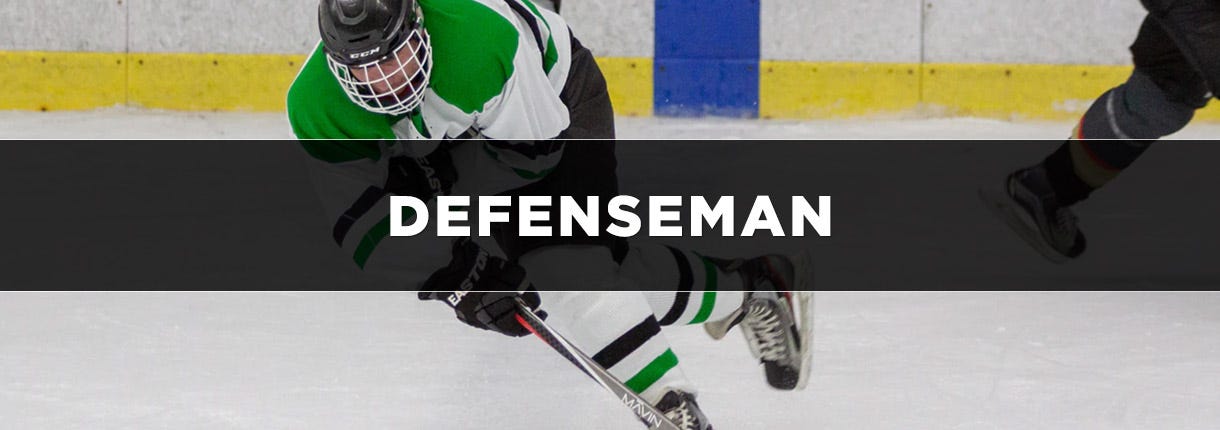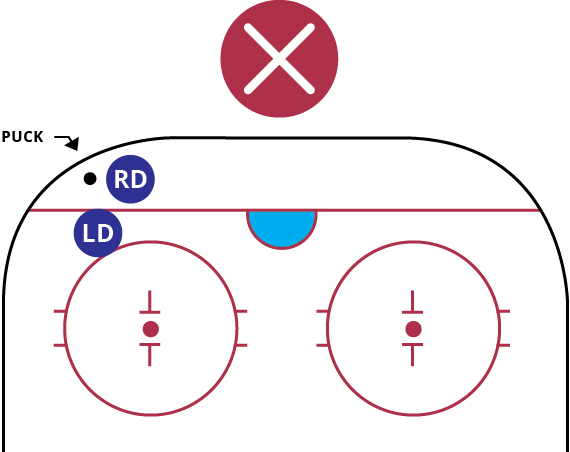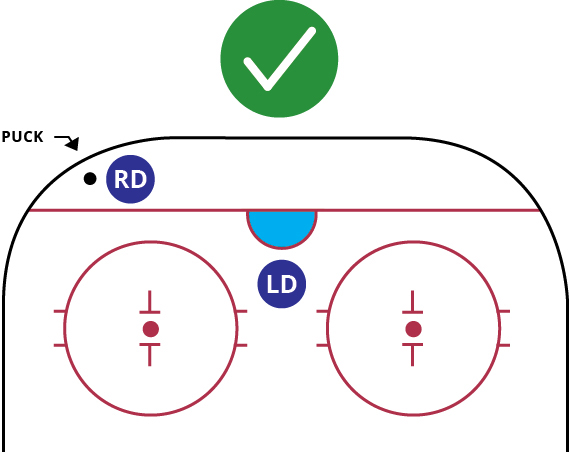Hockey Defenseman: How to Play Defense in Ice Hockey

Most sports fans have heard of the saying that “defense wins championships” and this adage certainly applies to Ice Hockey. Elite defensemen are essential for any hockey team. While the basic skills and responsibilities of a defenseman may seem obvious, they possess certain attributes and perform tasks that often go overlooked. Throughout this article, you can expect to learn about these responsibilities of a defenseman, hockey defensive positioning, hockey defensive strategy, and their tasks for specific on-ice situations like power plays, penalty kills, and faceoffs.
- Responsibilities as a Defenseman
- Defenseman Play and Positioning
- Defenseman Play and Positioning (Offensive Zone)
- Neutral Zone Responsibilities
- Playing Defense on the Power Play
- Playing Defense on the Penalty Kill
- Playing Defense on Faceoffs
The overarching responsibility for a Hockey Defenseman is to ensure that the puck is not scored on their net by the opposing team. Although defensemen are responsible for a variety of different tasks in order to help their team win. Some of those other key responsibilities include:
- Being a strong and skilled skater, especially backwards: Strong-skating defensemen have the ability to quickly turn around and backskate if the opposing team gets out on a fast break. A skilled back-skating defenseman will have the ability to contain the quick wingers of the opposing team.
- Possess great hockey defensive positioning: The rule of thumb is to always keep yourself in between the puck carrier and the net to ensure you are not leaving any part of your zone uncovered. A defenseman should never turn their back to the puck, allowing you to always be aware of where it is, but you will also want to keep your head on a swivel to make sure teams aren’t finding open areas within your zone.
- Have good stick skills: This includes a variety of different tasks. For starters, as a defenseman, you will oftentimes be the player responsible for making a clean, crisp outlet pass to a winger skating out your zone. Secondly, you will want to have a good, heavy shot, especially from the opposing team’s blue line. This will make you a viable scoring asset on offense. Third, develop an effective poke check and know when to use it. Poke checking can be a great skill to possess in order to slow down, or completely stop, an opposing player in their tracks. Strong stick skills start with the right hockey stick and hockey gloves to ensure you are using the best equipment for you.
- Have great hockey IQ: While this may come with experience, defensemen are typically the players who control the play while it is in their defensive zone. This includes angling opposing players to non-ideal spaces, communicating well with teammates to let them know if there is an open gap, as well as evaluating the play and anticipating what will happen next.
Defenseman Play and Positioning
Ice Hockey teams typically play with two defensemen on the ice at all times. These two defensemen will work in unison to prevent goals from being scored on their goalie. With this in mind, defensemen usually find themselves playing the majority of the game in two zones (while the puck is in their defending zone).
Zone 1 (Slot Zone)
Starting with arguably the most important zone for a defenseman is the “Slot Zone”. Within this zone, and just outside of it, are the highest percentage scoring areas on the ice, so it is important to have one defenseman in this zone at all times. If the puck is in the left corner of the ice, it is the right defenseman’s responsibility to slide over and lock down the “Slot Zone”, and vice versa. Doing the two tips suggested below will help defensemen achieve this.
Keep Your Head on a Swivel
As briefly mentioned earlier in the article, it is imperative for a hockey defenseman to keep his head on a swivel. What this means, is look to your left and right, as well as behind you. Doing so will allow you to read plays as they happen and prevent opposing players from being left open in this zone. If there is an opposing player who camps out in this zone, be sure to use your size to your advantage to nudge him out of the way. Furthermore, it is also always a good idea to make sure that this players stick does not touch the ice too much by lifting his stick with yours. If his stick is not on the ice, it eliminates the chances of him scoring!
Don't Chase the Puck
Another hugely important tip for a hockey defenseman is to not chase the puck! This means sticking to your general area within the defensive zone. For example, if the puck is in the right corner, the left defenseman should not skate over to this corner in the attempts of getting the puck back. Doing so, he will have turned his back to the opposing winger, which could lead to a pass and a high-percentage scoring chance. If the puck is in a corner, the opposing defenseman should not go further than the midpoint of his net, therefore locking down the “Slot Zone”.


Zone 2 (Corner Zones)
Just as important, are the two corner zones within the defensive zone. If the puck pops into one of the corners, your goal as a defenseman is to be the first one to it. Often times, there will be an opposing player there as well, so you will want to use your size and try to get the puck! If you are able to win the battle, and get the puck, you can start looking for open teammates up the ice and hit them with the pass. There will be times, though, where the offensive player will win the puck over you. Listed below are some tips you can follow for when that does happen.
Position Yourself Well
If an opposing player has the puck in the corner, it is important for you to play positionally well and be aware of the player who has the puck. What this means, is that you will not want to just charge at the opposing player, especially if that player is crafty with the puck. Rushing at a player like this, will make it easier for him to blow right past you. Instead of rushing at him, try getting your stick in front of his to take away potential scoring chances, get your stick in the middle of passing lanes, and use your size and range to your advantage if he does try to skate around you.
On the contrary, there are times when applying immediate pressure is recommended. For example, if you know the opposing player isn’t too quick on his skates or does not have the best stickhandling skills. Additionally, if a player in the corner receives a pass in which he has to turn his back to you to catch it, this is also another good time to apply pressure to him right away. This is because he is unable to see you and which direction you are coming from, allowing you to potentially steal the puck away.
Play Your Corners
Another tip to keep in mind when the puck goes into the corner is to be aware of who is there. What this means is, it is never a good idea to have a defenseman and winger of the same team in the same corner for too long. This could lead to wide open back-door passes from the opposing team. For example, if the puck goes into the left corner and the Left Winger goes into the corner to battle for it, it ok for the defenseman to help contain it, but play more of a supporting role. If the defenseman is aware of a winger already battling with an opposing player for the puck, it is recommended to stay back a little bit, keep your head on a swivel, and be on the lookout for any players cutting towards your net looking for a pass.
However, more times than not, the winger battling in the corner will rely on the defenseman to swap spots with him. This means that these two players will swap roles, making you the one responsible for gaining possession of the puck allowing the Left Winger recover back to his zone (covering the opposing right defenseman).
Defenseman Play and Positioning (Offensive Zone)
While defensemen in the offensive zone have a much simpler time compared to when they are in their own defensive zone, they are still an important component to a teams’ offense. Their three main objectives include keeping the puck in the offensive zone, prevent the other team from starting a fast break, and make smart decisions with the puck whether that be a shot on net or a pass to an open winger.
Keeping the puck in the offensive zone consists of more than standing in one area hoping it never crosses over the blue line. If the puck is in the left corner of the zone, the left defenseman will remain at his blueline in his normal area. The right defenseman, however, will shift over close to the center of the blue line. And vice versa when the puck is on the right side. This is to prevent defensemen from being out of position if a fast break were to happen by the defending team.
Playing with Your Partner
As a Defenseman in the offensive zone, it is also important to keep in mind what your Defensive partner is doing. The two tips listed below are important concepts to keep in mind:
Know Your Personnel
For the most part, Defensemen have two styles of play. One will be more offensive-minded, be more comfortable stickhandling the puck, and not look to take too many hits. Typically this type of players’ Defensive partner will essentially be the exact opposite. He will be a more defensive-minded, “stay at home” type of player, meaning he won’t venture out of his zone too much with the puck. With this in mind, it is important to recognize who you are playing with and their play style and learn how to cater towards each other's play styles. Figure out who is the better skater, passer, shooter, and so on to determine how to support and back each other up.
Play Smart
Play smart, heads-up hockey. This encompasses a lot of different facets of the game, but for Defensemen, most of the game is about being in the right position at the right time. For example, the term “pinching” is often used. Let's say the puck pops out and is on the right side of the zone, along the boards, about halfway up. Typically the right defenseman will pinch, meaning they will skate towards it with the hopes of either taking a shot or dumping it down further into the zone. When this happens it is the left defenseman’s responsibility to slide over and cover for the right defenseman. At this point, the left defenseman would be past the halfway point of the blueline, to prevent a fastbreak going the other way if his partner ends up not getting to the puck in time. Your job as the Left Defenseman is to very quickly react to the outcome of the play. If your partner gets the pack, remain ready in the offensive zone. If your partner does not get the puck, immediately start back skating into the neutral zone to prevent any stretch, breakout passes by the opposing team.
Another thing to keep in mind here is to be aware of what your teammate does with the puck and how to react depending on the result. If your partner takes a shot on net, the objective is to get it onto the opposite goalie, but this doesn't always happen. Sometimes it will get blocked by an opposing Winger or Defenseman. When this happens, start back skating to prevent any breakout passes. Also, be on the lookout, with your stick on the ice, for a pass from your partner.
Shooting the Puck
Look At Your Target
Keep your head up and look where you are shooting. It sounds simple, but sometimes it's easier to just fire the puck at the net as soon as it makes contact with your stick. Doing this can result in the puck hitting the shin guards of the player defending you, leading to a fast break going the other way. The goal is to be able to look where you want to shoot before it gets to your stick. Doing so will also help you determine whether or not you want to shoot the puck or pass it, which we will discuss in the next section.
Shoot Smart
Take smart shots. Usually you will want to keep your shots below knee level from the point. Focus on accuracy. The objective here is to have the puck make it through the “traffic” and potentially produce a big rebound if the puck bounces off the goalies pads. This is also a good way to quickly get the puck into the high scoring area (slot area, between the hash marks and goalie crease).
Passing the Puck
Make Quick Decisions
From the point you will pass more than you shoot. With this in mind, you will want to make quick decisions with the puck. Keep your head up, quickly spot open teammates and fire off a pass on their stick blade.
Keep the Puck Moving
Another thing to keep in mind while you have the puck at the point in the offensive zone is to never stand still with it, usually no more than three or four seconds. This forces the players defending to keep moving as well, giving your teammates a chance to find open space. If they do, fire off a quick pass to them on their stick blade.
Keeping the Puck in the Zone
Seal the Boards
Keeping the puck in the offensive zone is crucial for any defenseman. You can use any part of your body to keep the puck in. Sometimes doing so is easier said than done. If they puck is traveling quickly along the boards, a tip here is to use the back of your skates, legs, and backside to “seal” the boards to prevent the puck from getting past you.
Neutral Zone Responsibilities
Your team won’t be able to keep the puck in the offensive zone for the entire game. When the defensive team comes up with the puck, as a Defenseman you have two main options. If you notice that the player on the other team with the puck doesn't have great stickhandling skills, or does not have any options for passes, and your defense partner is in a good position, you can challenge the skater here and try to get the puck from the defenseman.
On the contrary, if the opposing player skating out of his defensive zone is quick and does have good stickhandling, you will want to start back skating into the neutral zone, get good defensive positioning, and try to slow the pace down. This gives your forwards time to backcheck. If the opposing player with the puck is skating full speed up the ice, use your body and positioning to force him outside (meaning closer to the boards). You do not want him getting to the slot area of your zone!
Playing Defense on the Power Play
Power Plays are given to a team when the opposing team gets penalized for an infraction they committed. The team on the Power Play will keep the standard five players on the ice, while the team who committed the penalty will play with four. Power Plays are a great opportunity for teams to set up plays in the offensive zone, control the pace of the game, and tire the defending team down.
While there are many different Power Play formations, the objective is to work the puck around the outside of the offensive zone, looking for the right time to strike.
With the puck on their stick, a defenseman has the option of dumping it down into the zone, hitting the center or wingers with a pass, or taking a shot on net if they have an open lane. The opportunity to do any of these options is enhanced because the wingers of the defending team will be forced to come out a little bit further (closer to the defenseman) than they would it if were 5-on-5. If a defenseman opts to take a shot from the point, his defensive partner should immediately assume a defensive position in case the shot is blocked and deflected to the opposing team. Doing so will help prevent against a fastbreak. Following the shot, the defenseman who took the shot should be on the lookout for potential rebounds, either to backcheck or for another scoring opportunity, depending on who gains possession of the puck. While the threat of a fast break going the other way from the opposing team still remains, it is important for the defensemen to not get too close to the net. Usually the “cut-off” point for this is the top of the circles.
Playing Defense on the Penalty Kill
There will be times when your team gets called for an infraction and has to go on the penalty kill, meaning four players on the ice to the opposing team’s five players. Like power plays, there are various different formations for your team on the penalty kill, but the most common is the standard “box”. Because of the loss of a teammate, the four penalty killers on the ice will create a box formation in front of their own net, standing about 8 feet away from each other. The goal here is to keep the opposing team to the outside of the ice, meaning all four players will not deviate too much from this setup. The two defensemen will be the two players closest to their goal and their primary objective while on the penalty kill is to waste as much time as possible, with the hopes of the penalty time expiring, and keeping the opposing team from scoring. This means holding the puck for as long as possible, or dumping it down the ice to further kill time on the penalty clock.
A recommendation for defensemen on the penalty kill would be to play a touch more conservative as opposed to how they normally would when the game is 5 on 5. As there is more room for error on a penalty kill, this means less-aggressive pressure on the puck carrier if it is in the corner. Doing so would further increase his scoring chance if he did end up going past you. Going hand in hand with this is to keep your head on a swivel, more so than you normally would. Doing so, will better help in noticing any cuts towards the net by opposing players.
Playing Defense on Faceoffs
Defensemen also play a key role on faceoffs as well. A well-planned faceoff can result in a great scoring opportunity as long as everyone is familiar with what their role is. While in the offensive zone, defensemen will want to be ready on their toes in case the faceoff is won. If it is won, often times it will pop back to you for a one-timer shot on net or a pass to his defensive partner. If the faceoff is lost, their job is pretty simple. Be aware of where the puck goes when the other team has it and play good defensive positioning. If the faceoff is in the neutral zone and is won back to the defenseman, it is their responsibility to look for open teammates to start an attack into the offensive zone. If it is lost in the neutral zone, just play defense as normal. If a faceoff in the defensive zone is won, defensemen are looking to quickly move the puck up the ice, known as a breakout. This can be done one of two ways. Either by a pass up to a winger, or by skating it up the ice. Passing it up is the most common, but one thing you will almost never want to do as a defenseman is to attempt to pass the puck across your zone, in front of your goalie. Doing this could lead to a potentially easy steal by the opposing team and an easy shot on net.
In conclusion, defensemen in Ice Hockey are a critical part of the game. Not only are they the main players responsible for slowing down the opposing team, they can oftentimes be the ones looked at to control the pace of the game, especially within the defensive zone.











